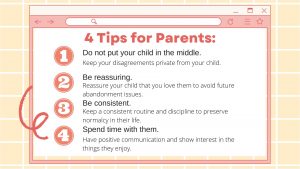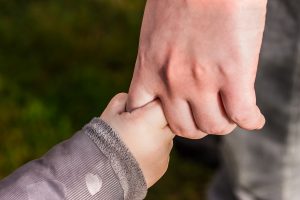6 Divorce
Clare Maloney
Introduction
It is no secret that divorce is common in the United States (US). In 2019, the Centers for Disease Control and Prevention (CDC) found that roughly 37% of all marriages in the US ended in divorce.
The most commonly reported causes of divorce were narrowed down to lack of commitment, infidelity, and arguing (Scott et al., 2013). The trauma of divorce can affect a child’s development in many different ways. These effects can disrupt children’s mental and physical well-being and put them at high risk for toxic stress (Crowley, 2021).
Effects of Divorce on the Child
Every divorce affects children differently, but these are some of the common issues that will arise for children who are going through parental separation:

For details on how each of these losses can impact the child, navigate to this article. Author Jane Anderson (2014) gives a great overview of each of these effects.
When divorce occurs, caretakers should observe a few key areas during a child’s formative years. One example is monitoring the child’s academic performance. Experiencing a divorce can lessen a child’s academic motivation and cognitive abilities, such as reading, thinking, and reasoning (Anderson, 2014). A study by Jeremy Arkes (2015) found a sharp decline in the reading scores of children with divorced parents in comparison to their classmates. When repeating this on the same children two years later, there was not much improvement in the test scores. Caretakers should monitor the two-year period after a divorce for impacts on the child’s academic performance (Arkes, 2015). Strategies include helping them with homework, checking their grades regularly, communicating with the teacher, and working with their child to explain concepts that they do not understand.
Another key area for divorced parents to monitor is their children’s emotional well-being. In many cases, this type of trauma can expose children to neglect, blame, anger, sadness, and many other strong emotions they may be too young to process. If these emotions remain unaddressed by a parent or a professional, they can be at high risk for psychological effects such as depression, anxiety, toxic stress, and even suicidal thoughts (Crowley, 2021). Without regaining a sense of emotional security, they will likely never learn how to properly cope with most types of emotional distress (Anderson, 2014).
To prevent this, the caretaker should ensure the child has a strong support system. This can be done by seeking professional help, having open and honest communication, separating them from conflict, encouraging them in the activities they enjoy doing, and making sure they constantly feel loved. By taking these steps, parents prevent future behavioral issues and maintain their child’s healthy emotional well-being (Crowley, 2021).

Effective Parenting Practices
A child’s relationship with each parent greatly influences their development. Having both parents play an active role in their child’s daily life has been shown to prevent divorce’s negative effects on the child (Dush et al., 2011). This is called co-parenting. Learning to co-parent peacefully is one of the most important actions that divorced parents can take to ensure the mental and emotional well-being of their family. A positive co-parenting relationship can make the child feel secure, provide consistency, teach them to understand problem-solving and give them a healthy example to follow. When the child feels confident that both parents love them, they can adjust to the family transition more easily and it can improve their self-esteem (Block and Smith, 2020).
There are specific ways that parents can practice peaceful co-parenting. First, it is necessary to separate feelings from behavior and stay focused on the child. If parents feel anger or resentment towards each other, those emotions can unintentionally be projected onto the child. Second, parents should never put their child in the middle of the situation. The child should never be used as a messenger between parents and they should not hear negative comments about either parent. The parents need to remain on the same team when interacting with their child. Additionally, peaceful co-parenting should have consistency when it comes to rules, discipline, having a set schedule, and showing respect for one another (Block and Smith, 2020). To learn more tips on how to co-parent peacefully, navigate here.

Resources
Many resources benefit both children and parents when going through a divorce. The best way to become aware of these resources is to talk to a counselor and research them yourself. Here are some helpful online resources for adults:
- National Parent Helpline
- The National Parent Helpline contains information on how to improve parenting practices. It lists a number of resources ranging from parenting classes, online parenting communities, tips for single parents, and support for stepparents. It contains legal assistance, in-person groups, national emergency numbers, and mental health information.
- Co-parenting and Joint Custody Tips
- Co-Parenting and Joint Custody Tips for Divorced Parents provides ideas for parents on how to co-parent peacefully.
- Preventing Child Abuse and Neglect
- Preventing Child Abuse and Neglect is a webpage that can be used to help parents understand the effects of emotional neglect on their child and provide information to promote the child’s wellbeing.
- Beech Acres Parenting Center
- Beech Acres Parenting Center is a beneficial resource for parents to teach their children how to cope with a situation such as a divorce. It provides information for each age group and includes tips from experts on how children of certain ages respond to divorce.
Key takeaways
- Divorce can negatively impact a child’s development and can put them at high risk for mental illness, emotional neglect, and toxic stress.
- It is important for caretakers/parents to learn how to co-parent effectively and remain focused on their child’s wellbeing and quality of life.
- Both the parents and children that go through a divorce experience emotional distress; learning the proper coping mechanisms to maintain a healthy lifestyle should be done by seeking professional help.
References
Anderson J. (2014). The impact of family structure on the health of children: Effects of divorce. The Linacre Quarterly, 81(4), 378–387. https://doi.org/10.1179/0024363914Z.00000000087
Arkes, J. (2015). The temporal effects of divorces and separations on children’s academic achievement and problem behavior. Journal of Divorce & Remarriage, 56(1), 25–42. https://doi.org/10.1080/10502556.2014.972204
Block, J. and Smith, M. (2020). Parenting: Co-parenting and joint custody tips for divorced parents. HelpGuide. https://www.helpguide.org/articles/parenting-family/co-parenting-tips-for-divorced-parents.htm
Centers for Disease Control and Prevention. (2021, May 4). Marriage and divorce. https://www.cdc.gov/nchs/fastats/marriage-divorce.htm
Crowley, J. (2021, September 6). The effects of divorce on children: A parent’s guide. Survive Divorce. https://www.survivedivorce.com/divorce-effects-children
Dush, C. M. K., Kotila, L. E., & Schoppe-Sullivan, S. J. (2011). Predictors of supportive co-parenting after relationship dissolution among at-risk parents. Journal of Family Psychology, 25(3), 356–365. https://doi.org/10.1037/a0023652
Scott, S. B., Rhoades, G. K., Stanley, S. M., Allen, E. S., & Markman, H. J. (2013). Reasons for divorce and recollections of premarital intervention: Implications for improving relationship education. Couple & family psychology, 2(2), 131–145. https://doi.org/10.1037/a0032025
the act or fact of having a romantic or sexual relationship with someone other than one's husband, wife, or partner

